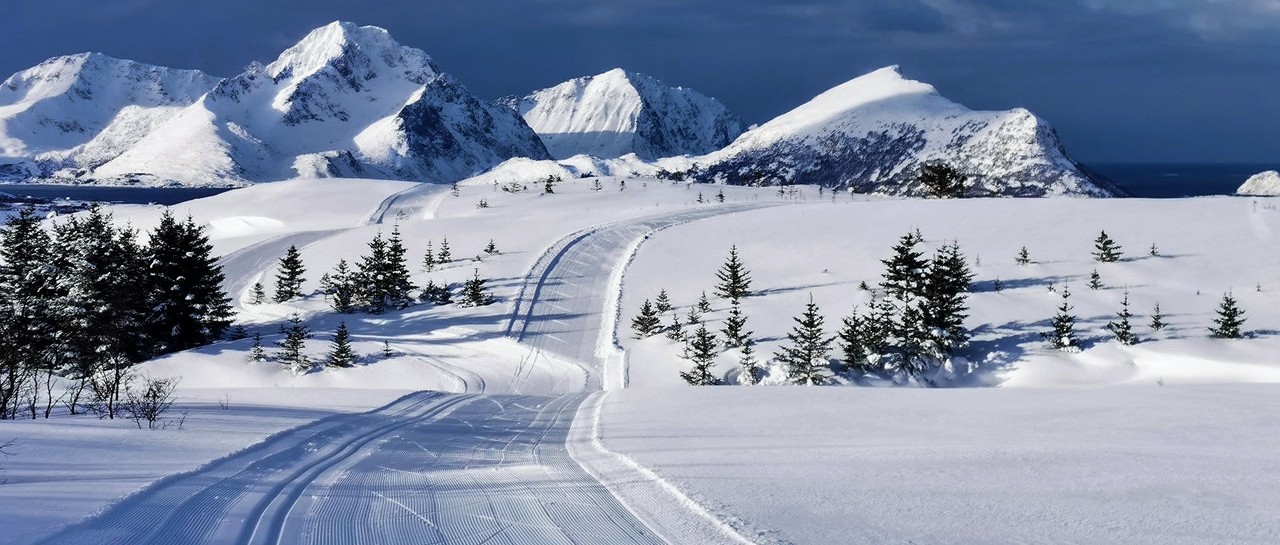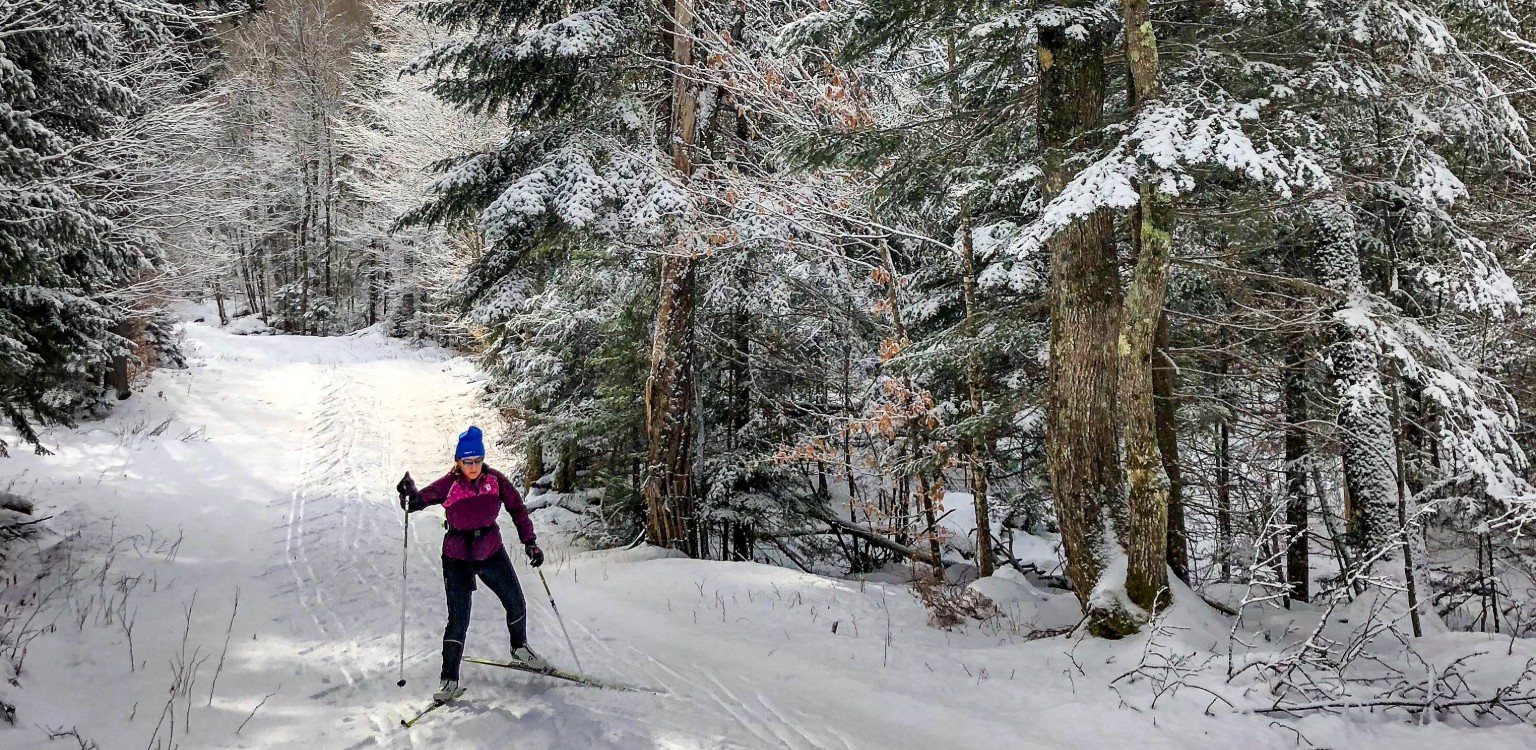
What is Cross Country Skiing?
Cross-country skiing takes place on flat groomed tracks, using skis which are longer, lighter and narrower than alpine skis. The skier propels themselves along using the grip under the skis. There are two type of cross-country skiing; skating and classic, which although they differ slightly in technique, are very similar in principle.

Modern skiing originated in Scandinavia as a means of transport, rather than the fun sport and winter hobby we now know it as. The earliest evidence of skiing comes from Russia way back in 6000 BC! It is thought that originally skis were developed to allow people to travel and hunt during the winter. Not until the 18th Century was it turned from a necessity into a hobby and a sport.
There is a perception of alpine skiers that cross-country skiing (xc-skiing) is somehow a more boring and tamer version of skiing, compared to rocketing down a mountain face on alpine skis. While it is true in part that cross-country skiing does not deliver the same adrenaline-fueled day in the mountains as alpine skiing, there are many other aspects of cross-country skiing that alpine skiing does not deliver.
Cross-country skiing involves skiing across generally flat surfaces, with most ski resorts have specifically groomed tracks for cross-country skiers. Cross-country skis have a special grip on the underside of the skis allowing the skier to push yourself forward in a ‘walking like’ motion or else in a skating motion depending on which type of cross-country skiing you are doing. This is achieved by the ski boots only being attached to the cross-country skis at the toe, allowing the heel to lift in a ‘walking-like’ motion.
There are two different types of cross-country skiing, involving very different movements and slightly different skis. These are ‘skate’ and ‘classic’. Both types of cross country skiing are done on groomed trails, however ‘classic’ involves more of a walking/ hiking style in grooves on the track, whereas skate cross-country skis are designed to allow you to literally skate along the snow, as you would imagine an ice skater doing. Skating cross-country skiing is much harder work than classic cross-country skiing, due to the wider range of muscles needed and the extra effort required to propel yourself along using a ‘skating’ motion.
Who can go cross-country skiing?
Everybody and anybody can go cross-country skiing! It is a sport designed to appeal to all ages. Anyone who has ever been out for a jog can give cross-country skiing a go. With a comparable, if not an even higher number of calories burnt compared to running, cross-country skiing is a super healthy and energetic sport. As with normal alpine skiing, cross-country skiing is a fantastic way to get into the open outdoors and fresh air! There is no better way to clear your mind and reset, than exposing yourself to the chill of fresh air and spending time in the mountains and nature. This is one of the things I love most about any sort of skiing!
What’s so good about cross-country skiing?

As I mentioned above, cross-country skiing burns as many, if not more calories than running, meaning the health benefits to this active sport are huge. A further advantage to cross-country skiing compared to other types of sports (alpine skiing included) is the full-body workout cross-country skiing gives you. As you are propelling yourself forward using your legs and core, while using your arms to push yourself along with poles, most muscles in your body are constantly in use. There are few other sports which require such a commitment from your entire body.
Another advantage cross-country skiing has over running (aside from the fact you are in the mountains and the snow) is the impact running has on your joints. In this respect cross-country skiing is much better for your body than running, as you get a better all-body workout, and your muscles and joints are better protected from any impact running or other contact sports may have on your body.
Main differences between alpine skiing and cross-country skiing
The most obvious difference between alpine skiing and cross-country skiing is the shape and design of the skis. Cross-country skis are much thinner, longer and lighter than their downhill counterparts. This is simply to make gliding along the flats that bit easier and faster. Using skis this light and thin going downhill would not end well! They wouldn’t have the strength and rigidity to withstand the pressure of going at speed. Another important factor when deciding between the two different types of skiing is what sort of activity you are after. Obviously downhill skiing gives you much more of an adrenaline rush if this is all you are after on your holiday. If however, you are keen to spend a bit more of your time exploring pre-groomed tracks around the base of the mountains and into the open space, taking time to appreciate nature, then cross-country skiing may be more attuned to the type of holiday you are looking for.
Another major difference between alpine skiing and cross-country skiing is the type of ski boots you will be using. Cross-country ski boots are a lot softer and frankly a lot more comfortable than alpine ski boots, which are very rigid and stiff. Cross-country ski boots should fit something similar to a trainer and actually feel quite comfortable!
Due to cross-country skiing generally taking place at lower altitudes and in more sheltered areas of the mountains, as well as it being a more active and energetic sport than alpine skiing, not as warm clothing is generally needed. Obviously, you will find yourself in the winter and in the snowy mountains, and therefore temperatures will be very low, however you won’t find yourself needing as much insulation as you may do for alpine skiing.
Do I need a lift pass for cross-country skiing?
Yes, you most likely will need to purchase a day pass for cross-country skiing – nothing in life is ever free! Although there are no lifts to be taken necessarily, often ski patrol will be on the cross-country tracks to check ski tickets. Cross-country ski tickets will usually be much cheaper than buying a lift pass for the mountain, however it is important to purchase one.
Cross Country Skiing - National Sport
Cross country skiing is the national sport of Norway. Skiing and winter sports are extremely popular in each of the Nordic countries. Norway, Sweden, Finland & Denmark have dominated the winners and runners up medals in the Olympics for this sport since cross country was included as Olympic sport.
Cross country skiing can be divided up into 12 different events. Not all of these events are participated in by both the men's and women's team in the Olympic games and other sporting competitions, but rather a different mix of each of the different events for each team. The cross-country skiing events for men are:
- Sprint
- Team sprint
- 15km Individual Start
- 30km Pursuit
- 50km Mass Start
- 4 x 10km Relay
The men’s events in cross country skiing are:
- Sprint
- Team Sprint
- 10km Individual Start
- 15km Pursuit
- 30km Mass Start
- 4 x 5km Relays
International competitions for cross country skiing include the Winter Olympic Games, the FIS Nordic World Ski Championships and the FIS Cross-Country World Cup. Competitions test competitors across multiple skills such as endurance, strength, speed, skill and flexibility.
Where is Cross Country Skiing most popular?
Cross country skiing both as a sport and a hobby is hugely popular all over the world. Although this sport was created as a sport by Norway in 19th Century, there are plenty of fantastic places for cross-country skiing as it is extremely popular all around the world. Cross-country skiing is a favorite sport in Canada, USA, Germany and Austria amongst many others.